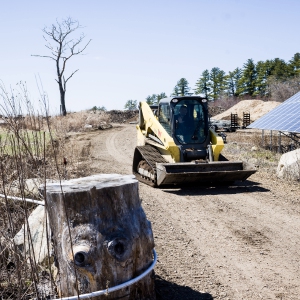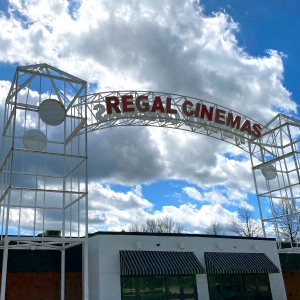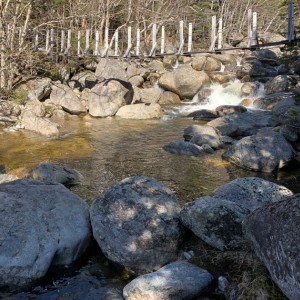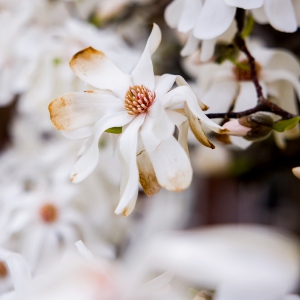A N.H. bridge over troubled waters is looking for an identity
| Published: 07-23-2018 12:14 AM |
At the Pumpkin Seed Bridge – a relic with a rich history and an uncertain future that spans the Pemigewasset River – a few seconds can seem like a long time.
Jump from the bridge itself, a 103-foot drop, and three seconds take on a new meaning. Videos on YouTube show a tiny figure up there, barely noticeable, sometimes unseen, until the jumper leaves that strip of iron and begins falling like a missile with engine trouble.
Jumping from the nearby 65-foot cliff creates the same effect. Sort of. While not as scary, this leap of faith is not your normal two-second trip.
The daredevils at Livermore Falls – in an area that blends Plymouth, Campton and Holderness – splashed down in rainforest-like humidity from those high cliffs, plus a rope swing tied to the bottom of the bridge.
No one dared tackle the bridge, though. Not on this day. Corey Allard of Manchester described the jump as “an adrenaline rush, that’s for sure. People have done (the bridge), but you’ve got to have (courage). I want to do it, but climbing the bridge is the big thing.”
The bridge is 132 years old, out of service since 1959. It means a lot of things to a lot of people. To Allard and others, the bridge represents a challenge, the focal point at this Shangri La that tempts yet scares them, forcing their jumps from cliffs not nearly as high as the one from the famous landmark.
Both jumps, from the bridge or the cliffs, have been deadly. Data is hard to find, but authorities say more than 15 people have died through the years jumping and many more have been hurt.
A Massachusetts man was the last person killed there. He hit a rock ledge in September.
Article continues after...
Yesterday's Most Read Articles
 ‘I thought we had some more time’ – Coping with the murder-suicide of a young Pembroke mother and son
‘I thought we had some more time’ – Coping with the murder-suicide of a young Pembroke mother and son
 Owners of Lewis Farm prepare to bring back agritourism after long dispute with city of Concord
Owners of Lewis Farm prepare to bring back agritourism after long dispute with city of Concord
 ‘Folks who use it should pay for it’ — City manager proposes clubhouse plan with smaller tax impact
‘Folks who use it should pay for it’ — City manager proposes clubhouse plan with smaller tax impact
 Who would invest in movie theaters these days? These folks
Who would invest in movie theaters these days? These folks
 The Appalachian Trail in New Hampshire just got easier, as another debate looms over replacing structures in wilderness areas
The Appalachian Trail in New Hampshire just got easier, as another debate looms over replacing structures in wilderness areas
 Concord stargazer puzzled over unidentified flying object
Concord stargazer puzzled over unidentified flying object
“It seemed like there was a fatal every year,” said Campton police Chief Chris Warn, who’s been on the force for 28 years. “That number has gone down, but there are a number of injuries from smacking the rocks. No one is allowed on the bridge, but you and I both know that this is not something that is easily enforced.”
So, how is the bridge defined, what does it represent, where is its place, when you combine it with the state-owned beach and those beautiful rocky cliffs and the falls that roar year-round?
The answer is it’s in limbo, because ideas have varied, and no one knows who owns the bridge. Officials from the three geographically tight towns involved wish they could figure it out. For now, the bridge is a mysterious structure with no obvious ownership, no paper trail to reveal whom it belongs to, and no official purpose as it stretches 263 feet above the river.
Not one of the four plugged-in sources I spoke to could figure out whose bridge it is.
Jane Kellogg is the chairwoman of the Campton Conservation Committee. She doesn’t know.
“We are (confused),” Kellogg said. “We’re trying to find out because it’s important. It goes back so far that we’re trying to get to the bottom of this.”
Tink Taylor is a former newspaper man and a member of the Friends of the Pemigewasset organization. As a state representative from Holderness 40 years ago, he chaired a study group to figure out what to do with the bridge. He doesn’t know who owns it, either.
“That’s question No. 1,” Taylor said. “The state would prefer they not own it. No one knows.”
Meanwhile, the bridge, old and tired, remains meaningful, in one way or another. Ken Evans coordinates the Friends of Pemi/Livermore Falls Chapter, created five years ago, and is a member of the Plymouth Rotary. Both groups continue to seek a solution. Evans feels the richness of this territory.
“The whole area is such an historical place, and it’s environmentally significant and, recently, recreationally significant,” Evans said. “It’s a very huge project, with a lot of different angles.”
The bridge has paid its dues, built above the river and Livermore Falls in 1886 for $7,000. Campton, which is connected on its east and west side by the bridge, initiated the idea, then sued neighbors Plymouth and Holderness to share the cost, believing the taxes paid solely by its residents were unfair.
The bridge served horses, wagons and foot traffic in those early years, before motor vehicles began rumbling over in the 20th century.
Then came industry – pulp mills, tanneries and a fiberwood company. The nearby railroad that hugs the river hauled logs in. The bridge opened the area to incoming materials and outgoing goods as the machinery hummed and the smokestacks smoked.
And cars rolled, although not smoothly, some remembered.
“My mother despised that bridge,” said Brenda Boisvert, the president of the Campton Historical Society. “She would go around it. It was high; it sounded rickety.”
It was. It closed in 1959, its east span cut loose and allowed to drop into the river to stop further crossings. Then came the changes and the history and the illegal jumping and the confusion.
Through the decades, the three towns tried to figure out what to do with this great structure that survived world wars and the depression and the Cold War.
The remains of the stone and brick mills are in view, foundations of another era with huge trees jutting from their insides.
But check through the historical data online. Read the timelines and the backstories. Talk to the people who have lived near the tri-town paradise for decades.
They know about some things. There were study commissions formed, meetings held, and an attempt to convert a mill into a hydro-electric plant.
Ownership of the surrounding lands changed hands, depending on who owned what business. There were giants of industry, names like J.E. Henry and the Parker Young Co.
By 1978, with the potential to create something great in the spot, Taylor, a Republican congressman from Holderness at the time, led a study commission that issued reports and recommendations.
Progress has been made. Nearly 42 acres became state property in 1992 through a Land Conservation Improvement Program grant. The state owns the nearby beach, which has a new parking lot, new picnic tables, new bathrooms and new grills. A homeowners’ association owns the land on the east side of the bridge.
Plus, a $150,000 penalty paid by the Groton Wind Farm was funneled to the state, and that will pay for another parking lot on the west side, near the railroad tracks. There will be a viewing area, a path leading to the water and tables.
Meanwhile, the area remained beautiful, its roaring rapids at the falls and massive cliffs creating jaw-dropping scenes. Add sandy beaches and thousands of trees that burst into color during the fall in postcard-like fashion, and at least there was one thing everyone could agree on: The state had a jewel on its hands.
None of which offered a solution to the Pumpkin Seed Bridge.
“I would like to see a viewing platform,” Taylor said. “What a spectacular view that would be.”
“It’s always been kind of a mystical item,” Boisvert said. “It’s a very high bridge, with lovely falls underneath.”
The balance here between illegal activity and tradition is a fine line. Fathers once jumped decades ago, and now their sons do the same, sometimes driven to the spot by those very same fathers.
Evans called it a “rite of passage.” The three towns call it a confusing mess. All these years later, they still hold meetings, exchange ideas, search for answers, wonder if the bridge is even worth saving and, if it is, who’s going to pay for the renovations.
“It’s an ongoing discussion,” Boisvert noted.
And that discussion, that cloud that hangs over the bridge even when skies are blue, has come back to haunt those trying to choose the best path forward. Taylor wants the Pumpkin Seed registered with the National Register of Historic Places, which would give it an insurance policy against people who think it’s ugly and dangerous.
“They say it looks like it qualifies, but they ask who owns it,” Taylor said. “The owner has to approve it.”
Taylor, who knows more about the bridge issue than anyone, cited a visit by the Society for Industrial Archeology, which sent engineering experts to view the bridge. They marveled over the old truss system. They loved the old rivets. They noted that this bridge is rare, one of the few of its kind left in the country.
And the rock formations around the bridge are made of a rare material, now called Camptonite, a name that has stuck nationwide.
Taylor knows all this firsthand. A few years ago, he climbed to the top of the bridge in his 70s to take photos and show the potential for a truly amazing tourist attraction.
“I got the whole view of the Pemi River looking north,” Taylor said. “The whole river, 40 to 50 feet wide, a rainbow, the roaring sound, the Plymouth to Lincoln railroad.”
The danger associated with the bridge and the accompanying cliffs, however, is never far from any discussion.
Plymouth State University is close by, and the area has the reputation for attracting partiers who have slipped and fallen on slick rocks.
Signs posted on trees say “Private Property, No Trespassing,” but that does little to convince jumpers that this is not a good idea.
The climb up to the cliff area is hard enough, with huge rocks and tree roots the size of Schwarzenegger biceps everywhere. Once on the edge, a thrust forward is needed to avoid the rocks below, and it’s easy to slip as you run to gain momentum.
Some young people I met seemed more nervous than others. Ben Helie and friend Corey Allard were there. They’re both from Manchester. One was more daring than the other.
After peering over the edge at 60 feet, Helie returned to the gentler 30-foot cliff and said, “No way, that’s too high for me. Way too high.”
Zak Kaplan of New York City said he could handle jumping from the bridge, but feared the climb up. So he settled for a 60-foot drop.
“It’s kind of high, but you don’t think about it,” he told me. “Just send it.”
Alicia Marston of Plymouth enjoys floating down the river, telling me, “Jumping seems way too dangerous with rocks and roaring water.”
And Anthony James of Connecticut was more than happy to swing from the rope. No cliff jumping for him.
“No, too many rocks,” James told me. “You don’t know what you’re dealing with, man.”
Boisvert does. She’s seen this spot, a combination of rare beauty and an undercurrent of danger. She says she gets an uneasy feeling sometimes when driving past the parking area.
She’s had the feeling for a long time.
“It’s very sad to me,” Boisvert said. “It seems like I can drive by there and see cars on a hot day, and if it’s before the college kids have left I think, ‘Oh my god, the chief is going to be doing water rescue today.’ ”
“That’s my first thought.”
(Ray Duckler can be reached at 369-3304, rduckler@cmonitor.com or on Twitter @rayduckler.)
]]>







 ‘I hate to leave’: Three-alarm fire in Loudon burns centuries-old home to the ground
‘I hate to leave’: Three-alarm fire in Loudon burns centuries-old home to the ground Photos: Signs of spring
Photos: Signs of spring 25-year-old Concord man identified as Steeplegate Mall RV fire victim
25-year-old Concord man identified as Steeplegate Mall RV fire victim
